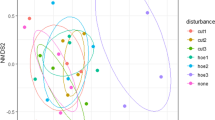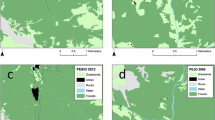Abstract
The long term effect of tourist trampling on a high altitudinal grassland (Caricion curvulae) in the Tyrolean Alps was investigated.
Even under slight trampling the frequency of sensitive species decreases. The most sensitive species were found to be fruticose lichens, followed by mosses, some forbs and broadleaved grasses. Tolerant to trampling are the dominant species Carex curvula, and Ligusticum mutellina, which do not disappear completely even at a tourist frequency of 150 tourists per metre per day. Trampling increases soil bulk density moderately but has no marked effect on the soil water content.
Comparison with high alpine sedge heath vegetation in North America shows a surprising uniformity of this vegetation type in response to trampling and also indicates that the common generalisation that alpine ecosystems are fragile and sensitive to disturbance does not hold true in this context. Furthermore these results represent evidence against the theory that ecosystems with low diversity are much more sensitive to arteficial impact than ecosystems with high diversity. However, if even the most resistant plants which are the dominant sedges are destroyed completely the rate of recovery is very low and may last for a long time. In the case of Carex curvula this is supported by the fact that it has very low seed production and grows mainly vegetatively. The rate of spread of the rhizome system of this species is 8 mm in 10 years. Similar figures may apply for the sedge species dominating in the alpine vegetation of North America. Thus fragility of this vegetation in regard to trampling does not mean low tolerance but low regeneration.
Similar content being viewed by others
References
Arrighetti, A., Cumer, A., Dellai, A., Parisi, V. & Tosi, L., 1977. Studio sull'effetto del calpestio umano in ecosystemi montani. Quaderni di ‘Esperienze e ricerche’, 3. Stazione sperimentale agraria forestale di S. Michele all'Adige.
Bates G. H., 1935. Vegetation of footpaths, sidewalks, cart-tracks and gateways. J. Ecol. 23: 470–487.
Bates G. H., 1937. The vegetation of wayside and hedgerow. J. Ecol. 25: 469–481.
Bayfield N., 1971. Some effects of walking and skiing on vegetation at Cairngorm. In: E. Duffey & A. S. Watt (eds.), The scientific management of animal and plant communities for conservation. Blackwell, Oxford. pp. 469–485.
Bell K. L. & Bliss L. C., 1973. Alpine disturbance studies: Olympic National Park, U.S.A.. Biol. Conserv. 5: 25–32.
Blom C. W. P. M., 1976. Effects of trampling and soil compaction on the ogcurrence of some Plantago species in coastal sand dunes. I. Soil compaction, soil moisture and seedling emergence. Oecol. Plant. 11: 225–241.
Blom C. W. P. M., 1977. Effects of trampling and soil compaction on the occurrence of some Plantago species in coastal sand dunes. II. Trampling and seedling establishment. Oecol. Plant. 12: 363–383.
Boorman L. A. & Fuller R. M., 1977. Studies on the impact of paths on the dune vegetation at Winterton, Norfolk, England. Biol. Conserv. 12: 203–216.
Cole D. M., 1978. Estimating the susceptibility of wildland vegetation to trailside alteration. J. Appl. Ecol. 15: 281–286.
Faliñski J. B., 1975. Die Reaktion der Waldbodenvegetation auf Trittwirkung im Liehte experimenteller Forschungen. Phytocoenologia 2: 451–465.
Crawford A. K. & Liddle M. J., 1977. The effect of trampling on neutral grassland. Biol. Conserv. 12: 135–142.
Dale D. & Weaver T., 1974. Trampling effects on vegetation trail corridors of north Rocky Mountain forests. J. Appl. Ecol. 11: 767–772.
Davies W., 1938. Vegetation of grass verges and other excessively trodden habitats. J. Ecol. 26: 38–49.
Ehrendorfer F., 1973. Liste der Gefäßpflanzen Mitteleuropas. Fischer. Stuttgart. 318 pp.
Elienberg H., 1978. Vegetation Mitteleuropas mit den Alpen. Ulmer. Stuttgart. 981 pp.
Grabherr G., 1979. Schädigungen der natürlichen Vegetation über der Waldgrenze durch die Anlage von Schipisten und deren Fähigkeit zur Regeneration. Tagungsberichte der Akademie für Naturschutz und Landschaftspflege. Laufen/Salzach-Bayern. 2/78: 45–52.
Grabherr G., Mähr E. & Reislgl H., 1978. Nettoprimärproduktion und Reproduktion in einem Krummseggenrasen (Caricetum curvulae) der Ötztaler Alpen, Tirol. Oecol. Plant. 13: 227–251.
Grabherr G., Brzoska W., Hofer H. & Reisigl H., 1980. Energiebindung und Wirkungsgrad der Nettoprimärproduktivität in einem Krummseggenrasen (Caricetum curvulae) der Ötztaler Alpen, Tirol. Acta Oecologia-Oecol. Plant. 1 (15): 307–316.
Kellomäki S. & Saastomoinen V. L., 1975. Trampling tolerance of forest vegetation. Acta Forest Fen. 147: 5–19.
Körner, C., 1980. Zur anthropegenen Belastbarkeit der alpinen Vegetation. Verhandlungen der Gesellschaft für Ökologie. 14: (in print).
Liddle M. J., 1975. A selective review of the ecological effects of human trampling on natural ecosystems. Biol. Conserv. 7: 17–36.
Liddle M. J. & Greig-Smith P., 1975a. A survey of tracks and paths in a sand dune ecosystem. I. Soils. J. Appl. Ecol. 12: 893–908.
Liddle M. J. & Greig-Smith P., 1975b. A survey of tracks and paths in a sand dune ecosystem. II. Vegetation. J. Appl. Ecol. 12: 909–930.
Lippert W., 1972. Veränderungen der Pflanzenwelt durch Bergsteigen und Fremdenverkehr im Hochgebirge. Ber. Bayer. Bot. Ges. 43: 5–15.
McQuaid-Cook J., 1978. Effects of hikers and horses on mountain trails. J. Envir. Mgmt. 6: 209–212.
Moser, W., 1975. Program on Man and the Biosphere. MAB-6 Obergurgl (Austria). Report 1975. Univ. Innsbruck.
Poelt J., 1974. Bestimmungsschlüssel europäischer Flechten. J. Cramer. Vaduz. 757 pp.
White, E. G., 1976. Preliminary investigation of soil erosion resulting from summer tourism at Obergurgl. (unpublished manuscript).
Willard B. E. & Marr J. W., 1969. Effects of human activities on alpine tundra ecosystems. Biol. Conserv. 2: 257–265.
Willard B. E. & Marr J. W., 1970. Recovery of alpine tundra under protection after damage by human activities in the Rocky Mountains of Colorado. Biol. Conserv. 3: 181–190.
Author information
Authors and Affiliations
Additional information
Nomenclature of species follows Ehrendorfer (1973) for vascular plants and Poelt (1974) for lichens.
The PCA calculations were done at the Computer laboratory of the University of Wales during a post doctoral stay at the School of Plant Biology in Bangor, U.K. I would like to record my thanks to Prof. Dr. P. Greig-Smith for fruitful discussions and reading the draft.
Rights and permissions
About this article
Cite this article
Grabherr, G. The impact of trampling by tourists on a high altitudinal grassland in the Tyrolean Alps, Austria. Vegetatio 48, 209–217 (1982). https://doi.org/10.1007/BF00055262
Accepted:
Published:
Issue Date:
DOI: https://doi.org/10.1007/BF00055262




